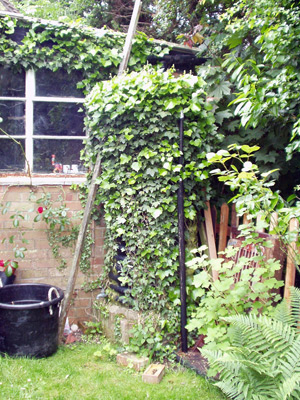Weeds and Weeding
Basics and how to
clear a neglected area
Weeds are sent to remind us that we borrow our gardens from the surrounding countryside, even if you live right in the heart of the city, it shouldn't really be like that and that mother nature wants it back.
Know your weeds
I'm not going to attempt to describe the hundreds - thousands, of plant species that are classed as weeds as it really doesn't matter too much, we just want to get rid of them so lets start with two broad categories.
Annual weeds
These grow from seed every year and frequently arrive after an area of previously undisturbed soil has been disturbed (they may have been sitting in the soil for years). The sudden exposure to light and oxygen stimulates dormant seeds into growth. They are fairly straightforward to get rid of as they tend to have shallow roots. The main danger with these is that they are prodigious seed producers and they run to seed very quickly after flowering, producing a huge amount of seed. "One years seeds - seven years weeds" is very true.
The famous poppies that covered the battle fields in the first world war grew quickly from the ground being disturbed by the rain of shells exposing millions of dormant seeds in the soil.
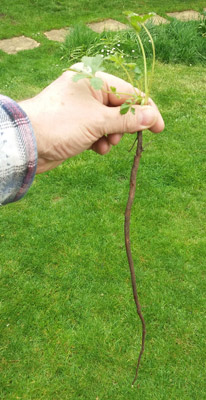
Perennial weeds
These are the hard cases of the weed world. They tend to have big strong roots, often tap-roots (like a carrot - but thinner and possibly longer) and so can come back again and again if the leaves are removed.
If you have moved into a neglected property or have neglected an area on your own property for several years, then it will be these hard to shift perennial weeds that have taken up residence.
They arrive by seed which germinates more slowly than annuals seed and is less abundant so they are not so obvious to start with. Slowly, they will out-compete the annuals and take over.
Each perennial weed is anchored to withstand a tornado and many have roots that fork continually in the soil, so when they are pulled up, there is nearly always part of the root in the soil to grow back. In fact so much of the plant is underground, that many will readily lose the leaves in a crisis all ready to grow them again.
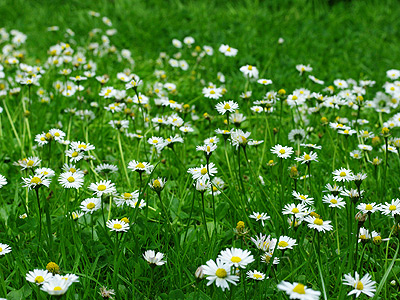
Appropriate weeds, some say that a weed is simply a plant growing where it is not wanted. These daisies in a lawn would be seen as weeds by some, but as charming flowering plants making the lawn more interesting to others. Likewise the ivy covering the waterbutt (picture right) could be a difficult to control weed, though here it helps to hide and soften a rather ugly object in a part of the garden where little else could cope with the difficult conditions.
How do I get rid of entrenched perennial weeds?
One of the commonest questions I get asked. There is no easy answer. You cannot go out this afternoon perform some low-effort special trick and be rid of them forever, while being able to lay your lawn from turf or sow your vegetable patch tomorrow or even next week.
If you have an area that is choked with perennial weeds, then you can't really plant anything else until the weeds are cleared, and that means the roots too!
A perennial weed has an underground store room and above ground leaves to fill the store room. If the leaves are removed, stores are taken to grow some more. As soon as the leaves are big enough, they can start to fill the store again. What you need to do is stop the leaves being able to fill the store, but just removing them isn't going to make the store go away. As far as the plant is concerned leaves and store act together as a long-lived seed producing factory. Perennial weeds grow relatively slowly and rely on outcompeting everything around them over the longer term.
Any method of ridding yourself of these weeds is going to be either time dependent or effort dependent. The less of one, the more of the other is needed. The real secret to getting rid of weeds is not to turn your back. Too often people pull them up and then leave them long enough to build up their strength again before pulling them up, then leaving them again etc. Once they're on the run, you have to keep at them until they're gone.
 Glyphosate
weedkiller
Glyphosate
weedkiller
For leafy weeds - A systemic
weedkiller that gets taken up by the leaves and carried to all parts.
Neutralised on contact with the soil, so not a persistent weedkiller
meaning that you can plant into the soil once the weeds have been killed
and removed. Best used during active growth on weeds with plenty of
leaf area to take it up.
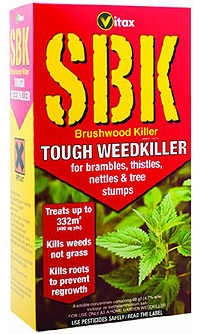 Brushwood
killer
Brushwood
killer
For tough woody weeds such as briars,
brambles, nettles, dock, tree saplings and tree stumps amongst others.
Selective broad-leaf weedkiller so will not harm grass, use in spring
and summer, usually requires around 6 weeks between use and re-planting
of braodleaved plants with the area.
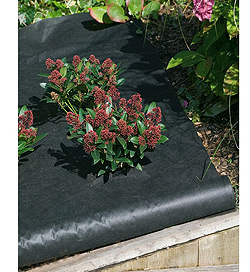 Weed
control fabric
Weed
control fabricA substantial fabric with a dense weave to prevent light getting through, allows water and nutrients to penetrate the soil. Can be cut (as an X) to allow plants to be planted through the fabric and suppress weeds nearby, best covered up with bark chips or similar to disguise the fabric once in place, requires pegging down at the edges. Also use under gravel areas, artificial lawns etc.
Method 1 - Time dependent weed removal
If you're not in a hurry, then your weed eradication programme will be a lot easier.
The non-organic approach - chemical attack. Use a glyphosate weedkiller, this is a systemic weedkiller which is taken up by the leaves and carried (translocated) all over the plant right down to the root tips too. It is neutralised on contact with the soil, but will kill any plants it comes into contact with. Don't remove any leaves before starting, you need the weeds to have the maximum area for take-up of the chemical. It is pretty slow acting and takes 2-3 weeks to kill all the foliage, don't touch the weeds for this time. It works best in spring and summer during active growth - at colder and inactive times of the year, it can be almost ineffective.
When the original foliage has died down, collect it up and dispose of it, I put it in the bin to be on the safe side. You then need to stand back and watch for recovery / regrowth - there will always be some. Let this grow again until there is a reasonable amount of leaf surface to take up more weedkiller and repeat spray. 2 applications are usually enough, though you may need 3.
If you have woody rather than leafy plants covering your ground, glyphosate won't be enough and you'll need a brushwood killer, the method of use is similar to glyphosate above, use the appropriate weedkiller for which weeds you have, leafy or woody.
The organic approach - non chemical, requires a lot more time. This relies on covering the weeds so that light can't get to them, start by cutting them back with shears, strimmer or even a rotary lawnmower set on the highest setting as long as the ground was fairly even and there was no danger of hitting rocks and stones. Then you need to cover the area with something - old carpet is a good choice as it's very dense and will block out all of the light and heavy enough not to flap about in the wind, just anchor down the corners and edges with bricks or similar. Plastic can also be used be used, but it needs to be dense enough to keep all light out, cheap bin-liners are too thin for the job and will rip and blow about everywhere.
Every month or so pull back the carpet, remove any growth and put it back again. The weeds will keep pulling on the store to produce more leaves, but the store never gets replenished. Eventually the roots die and your perennial weeds are gone - this could take a year or more. I'd recommend you mix and match this with the effort category methods too to reduce the time needed.
You could also grass the area over and mow them out - level the ground roughly, clear it and sow grass seed - the cheapest will do. Mow the grass regularly when it comes up and after a year or so most or all weeds will have been mown down continuously and killed and / or out-competed by the grass, there will most likely be perennial weeds surviving however. Start to dig the grass up in beds to plant what you want.
Method 2 - Effort dependent weed removal
Most people don't have the time or aren't prepared to wait months required needed to kill weeds by the above methods, so it's a question of some hard graft needed.
1/ root attack - It's not rocket science, using a garden fork start at one end of the area where the weeds are. Dig up a fork full of soil and then break it up with the fork, pick out the roots and shake the soil off, put them in a bucket - continue. The more thorough you are at breaking up the clods and removing pieces of root, the more effective your eradication will be. This can be very time consuming and digging out some weed roots is like trying to remove large balls of loose spaghetti from within the soil - you'll be amazed at how much stuff you can dig up from a small area but it will explain how the weeds keep coming back time and time again. You'll never get all of the roots out in this way, but you will reduce the stores very considerably. It can be a very effective way of initially dealing with old established weeds but of course depends on how thorough you are.
Put the weed roots in the bin, you can use them on your compost heap, but first they should be immersed in water for a few weeks to kill them first, use a brick to keep them down, an ancient Roman gardening tip that one.
2/ Leaf attack - Every time you remove the leaves you are depleting the stores. If the leaves get large enough, they will start to replenish the stores, so keep on pulling them up. or cutting the leaves off and eventually you will kill the weeds.
3/ Individual attack - this works well for individual perennial weeds in beds or lawns. Using a trowel or hand weeder tool, push it down by the side of the weed as deep as you can go and start a digging action until you hear/feel a "snap" of the tap root, the rest of the weed leaves and long portion of root can be removed with the other hand. This can be very satisfying if you can get a particularly long piece of root with the leaves attached. One of the best tools for this approach is an old narrow kitchen knife that you can push down and cut through the tap root below the ground.
The Combined Attack - Recommended Approach
Assuming a large bed of entrenched perennial weeds:
1/ Cut down and clear all top growth.
2/ Get out your garden fork and go for the "root attack"
method above.
3/ Leave to recover, when
there's a good amount of leaf, spray with
glyphosate weedkiller as outlined above.
4/
When the leaves have died and been cleared, dig the area over
with a fork again (it will be much easier than the first
time) and remove any weed roots as you go along.
5/ You may need to do some spot spraying
for bits of root that you missed, but this will clear most areas
in a reasonable time without killing yourself in the process.
Questions and Answers
Q. My walls are being attacked by ivy. What is the best and easiest way to eradicate it?. I have tried spraying with Roundup but it has little effect apart from killing a few leaves.
A. There's no quick and instant solution. The best way is to cut it off just above ground level and let the growth wither, apply a stump killer. It should be easy to pull off after a month or so. It will possibly re-sprout again from the stump. You may need to repeat the process.
The trick is to keep it on the run, if you leave it for any length of time, it will regain strength again and you're back to square one.
Q. How do I get rid of Ivy that is thriving underneath trees hedges, and on fences and that is generally 'invading' my garden
A. There's no easy way to do this and no particular trick to it. Your first assault should be physical, just go and pull it up as well as you can, a fork will help to lift some of the root from the ground. It will come back at which point when there's a good amount of foliage to soak it up - a weedkiller containing glyphosate that is taken down to the roots should be applied. I'd then alternate physical with chemical until it's gone, say a couple of each treatment.
Before you start all this though, consider what you'll be left with - probably lots of bare ground that if it's in the dry shade of trees won't really support anything else. I've an area at the bottom of the garden where a ramshackle old fence is covered with ivy growing in the shade of a large walnut tree. I trim the ivy with shears when it comes out sideways too far and it's kept off the lawn by the mower. There's nothing else that would grow in that place without suffering from lack of water and food or from pest or disease attack and also look so healthy.
So before you start attacking the whole area, decide in which places the ivy is a pest and in which places it' may be a blessing.
Q. We have recently moved into a new house where the garden has not been attended to for several years. The entire garden is taken up with a very ferocious weed which we have been told is "Japanese Knotweed".
We have tried digging it up several times but the roots seem to go down forever and we can't seem to get rid of it, it seems very determined ! We want to patio the area but need to get rid of the weed first.
We have 2 cats so am not sure what we can use to get rid of this weed without causing them any harm.
A. Japanese knotweed was introduced initially as a garden ornamental, but is now rapidly running amok in some parts (like in your garden!).
It is so invasive there are laws regulating what you can do with it:
Wildlife and Countryside Act 1981
Listed under Schedule 9, Section 14 of the Act, it is an
offence to plant or otherwise cause the species to grow
in the wild.
Environmental Protection Act 1990
Japanese Knotweed is classed as "controlled waste" and as
such must be disposed of safely at a licensed landfill site
according to the Environmental Protection Act (Duty of Care)
Regulations 1991. Soil containing rhizome material can be
regarded as contaminated and, if taken off a site, must
be disposed of at a suitably licensed landfill site and
buried to a depth of at least 5 m.
If you try and dig it out, you will invariably leave several broken pieces in the soil that will re-grow. With such perennial weeds, the only way to go is chemical. First of all dig as much up as you possibly can and take it down the tip if there is one nearby to you that will take it (i.e. not onto the compost heap). You could alternatively pile it up after cutting, let it dry out and then burn it, though do please consider the neighbours and any local by-laws about garden bonfires.
Stand back and let it re-grow. It will grow! but not quite so strongly as much of the food reserves are now down the tip or went up in flames. When there is plenty of leaf apply a weedkiller such as glyphosate, "Tumbleweed" or the like. Keep the cats out of the way while you do this, (anything gentle enough to be animal safe is also pretty plant safe). The weedkiller needs to be left a couple of weeks at least to do its job right down to the roots (follow the instructions on the container, you don't need to keep the cats out of the way all this time). There are more aggressive weedkillers though they are only available to professionals who could be contracted to sort the problem out for you.
Then have another go at digging and remove any remaining pieces. It depends on how bad your infestation is, you may be ok now, you will almost certainly need to leave it to grow and then weed kill again. Long winded and laborious, and may take a year or two or even more, but it will work.
Alternatively, if you are determined not to use chemicals, cover the whole area with old carpet or thick plastic, pull it up every so often and pull/dig the growing weeds, put the carpet back. In this way the weed roots will constantly be supplying energy to make new growth, but not be allowed to replace it by ever having any leaves in the daylight. This will take at least a year, probably more.
If there is no nearby licensed tip to take it, you could try the Roman method with pernicious weeds which was to drown them. Place the roots into a large container such as a water butt and put a weight on top to keep them submerged and leave for a few weeks or preferably months by which time they will be dead (and smelly) and ready for the remains to go on the compost heap.
Q. We have a privet hedge & want to replace this with a fence what is the best way to destroy & lift the privet.
A. Cut off at just above ground level and remove the stumps, you could leave a portion sticking out for leverage to help get the stumps out. Privet will sprout strongly from cut stumps if left. You could alternatively use a stump killer chemical.
Q. My husband is adamant that we have to remove all the Ivy that grows on and up our trees. I have asked numerous gardeners for their advice, and they say it doesn't do any harm, my husband still disagrees and says the Ivy will eventually kill the trees. Please can you confirm either way. Many thanks.
A. It's not really as clear cut as that. I wouldn't say it doesn't do any harm as the ivy is going to compete with the tree for water and nutrients from the soil and light in the branches. A large healthy tree shouldn't be too bothered by it, but a smaller or ill / damaged tree could be killed by the ivy. Not so much "killed" as pushed over the edge when it's already close.
I have a similar situation in my own garden with ivy eventually growing up anything vertical. Personally I don't like it much in trees and so I pull it off. My wife quite likes it so I let it grow up a few trunks but stop it short of the branches, it also does a brilliant job of covering up an large ugly water butt we have where I trim it off at the height of the lid.
It's not as black and white as your husband claims, but his view point is not without merit. I'd work on the basis of do you like it or not?
Copyright 2000 - present. All Rights Reserved | Privacy Policy Statement

